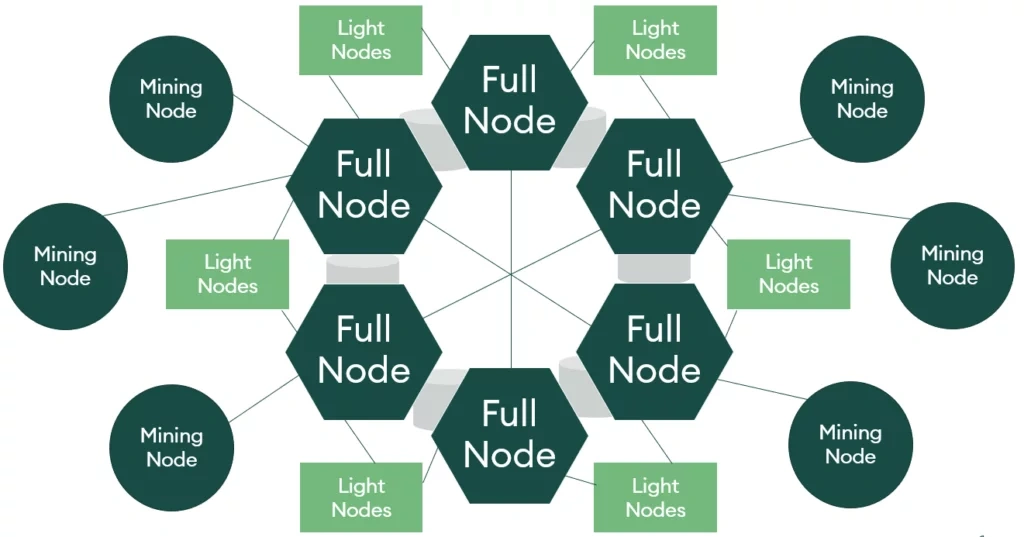Blockchain Nodes for Beginners: The Backbone of Every Crypto Network
Introduction: Blockchain Nodes for Beginners
When you first hear about blockchain nodes for beginners, it may sound intimidating—digital, invisible, complex. Yet at their core, nodes are simply the computers and servers that make cryptocurrencies like Bitcoin and Ethereum function securely and transparently. Without them, transactions would fail, data would be unreliable, and the promise of decentralization would evaporate. In this guide, you’ll discover what nodes are, how they work, why they matter, and how to set one up—backed by real data, not theory.
1. What Makes a Blockchain Node Tick?

Credit from AMINA Bank
At a fundamental level, a blockchain node runs software that connects to other nodes, storing or accessing blockchain data and enforcing protocol rules. They are the digital backbone of decentralized systems, ensuring every transaction and block adheres to consensus.
Nodes come in various forms:
- Full Nodes maintain the complete blockchain ledger. Bitcoin full nodes, for instance, currently demand hundreds of gigabytes if not more.
- Light (SPV) Nodes hold minimal data to verify transactions via trusted full nodes—useful for mobile wallets.
- Miner Nodes in Proof of Work systems (e.g., Bitcoin) compete to validate blocks.
- Validator Nodes in Proof of Stake systems (e.g., Ethereum post-Merge) participate based on staked cryptocurrency.
But how big are these blockchains in real terms today?
2. Blockchain Data Size and Hardware Requirements
Blockchains grow over time, and so do the demands on node operators. Real-world stats reflect this:
- An Ethereum full node running a standard Geth sync now requires around 1.4 TB of disk space (YCharts).
- Optimal hardware for Ethereum—processing layer and consensus layer—is now typically 8-core CPUs, 64 GB RAM, 4-8 TB NVMe SSDs, and high-speed internet (300 Mbps to 1 Gbps) (Cherry Servers).
- Archive nodes—especially on Ethereum—can demand ~12 TB on Geth or ~2 TB on Erigon, reflecting the need to store historical states (QuickNode).
These numbers underscore that running a node is no longer trivial; it’s a technical commitment — though accessible to determined enthusiasts.
3. How Many Nodes Are Out There? Real-World Distribution
Here’s how nodes are distributed across major networks as of mid-2025:
| Blockchain | Approx. Number of Nodes | Consensus Mechanism | Estimated Full Node Size | Key Insight |
|---|---|---|---|---|
| Bitcoin | ~23,400 reachable | Proof of Work | Hundreds of GB (varies) | Spanning 181 countries (Aug 2025) CoinShares |
| Ethereum | ~6,300 globally | Proof of Stake | ~1.4 TB (standard full node) | U.S. hosts 33% share CoinLaw |
| Bitcoin (reach.) | 22,939 (Aug 14, 2025) | — | — | Concentrated mainly in U.S., Germany, etc. Bitnodes |
These figures show not only how substantial these networks are but also how truly global — and resilient — they’ve become.
4. Why Nodes Matter: Beyond the Numbers
Nodes do more than just hold data; they uphold core principles of cryptocurrencies:
- Decentralization and Resilience: Thousands of nodes spread across countries prevent central points of failure or control (CoinShares).
- Security: Full nodes validate transactions based on strict protocol rules. Attempting to manipulate the blockchain would require controlling a majority of nodes—or the hash power, in PoW systems.
- Transparency and Trust: Since any node can independently verify every transaction, users don’t need to rely on third-party intermediaries.
5. How to Run a Blockchain Node for Beginners
Despite the rigor of requirements, running a node is within reach for interested beginners. Here’s a practical breakdown:
Select your blockchain (e.g., Bitcoin or Ethereum).
Obtain the official software — such as Bitcoin Core for Bitcoin, or Geth and a Beacon/Consensus client for Ethereum.
Sync with the network, which may take anywhere from hours (Bitcoin) to days (Ethereum).
Ensure proper hardware — a modern 8-core CPU, ample RAM, SSD storage, and stable internet are now advisable.
Maintain and update — nodes must stay online and aligned with the latest protocol updates to remain valuable to the network.
6. Challenges and Considerations

Credit from NordLayer
Running a node brings its own hurdles:
- Storage keeps rising, requiring upgrades over time—especially for fast-growing networks like Ethereum.
- Hardware costs are non-trivial when aiming for smooth performance.
- Technical knowledge matters for installing clients, maintaining uptime, and troubleshooting.
- Alternative entry points, such as light nodes or staking in PoS networks, offer easier yet valuable participation without full commitment.
7. Looking Ahead: Node Evolution
Emerging ideas aim to make running nodes more accessible and sustainable. For example, Ethereum’s Vitalik Buterin has proposed “The Purge,” a concept to reduce node size using history expiry and Merkle proofs, enabling new participants to join without storing the entire history (CCN.com).
Better client efficiency, user-friendly interfaces, and improved distribution among home users are also making nodes more democratic and resilient.
Conclusion: Blockchain Nodes for Beginners
Blockchain nodes for beginners might initially seem opaque, yet at their essence they’re your network’s watchdogs—validating each transaction, storing ledger history, and preserving decentralization. They’re essential to the functioning and trust of crypto systems. Whether you’re curious or ready to run one yourself, understanding the role of nodes is a crucial step into the heart of cryptocurrency.




